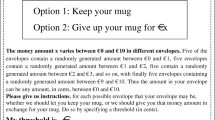Abstract.
A policy maker is asked a few simple questions about his preference. Then the model represents it by a quadratic utility function, which can be made monotonic and quasi-concave (= to provide the convexity of the preference). The design of the interview with a policy maker is aimed at attaining the following goals: (a) no ambiguous output (= degeneration of the model), (b) ordinal approach to preferences (= asking questions about ordinal preferences and providing the uniqueness of the ordinal preference at the model output, regardless of its representation by a quadratic utility function), (c) stability of the model (= the model's input–output transformation is continuous). We also describe briefly the implementation of our model in a user-friendly interface to a corresponding computer program.
Similar content being viewed by others
Author information
Authors and Affiliations
Rights and permissions
About this article
Cite this article
Tangian, A. Interview design for revealing preferences of policy makers. Rev Econ Design 7, 349–382 (2002). https://doi.org/10.1007/s100580200082
Issue Date:
DOI: https://doi.org/10.1007/s100580200082




